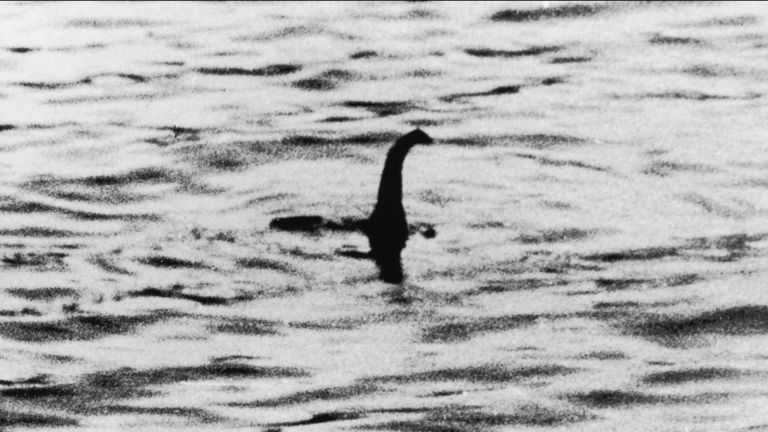
Niels Bohr had nine items, one too many for the express line, so he had to wait in a regular line behind a woman with five snot-nosed kids and two buggies overflowing with groceries. Bohr wondered if something had happened to the space-time continuum to make his wait in line seem more interminable than it already was. With nothing better to do, he scanned the rack of tabloids and noted the latest issue of the International Enquirer from that damned Carl Jung and his publishing house, the Unconscious Collective. Jung was at it again. This week, the front page featured shocking new photos of the Loch Ness Monster. The photos (allegedly) came from a German nanny on vacation with her employers in the Scottish Highlands. In an exclusive interview, she said that after putting the children down for their nap, she went to the banks of the lake for some time alone, and on her third beer, heard a great splash and turned to see a giant beast rising from the water. The way it’s neck curved, it looked like a cross between a swan and a brontosaurus. The nanny was lucky to have a camera with her, and even though she wasn’t able to get it in focus, the photo was good enough to give an impression of the beast and its enormity.
When it came his turn to pay, Niels Bohr pointed to the Enquirer and frowned. “Can you believe what Jung has the gall to print?”
“That one about Nessie?” And the kid behind the counter smiled.
“I am a man of reason. All my life I’ve dedicated my life to the cause of reason. And I can assure you: there is no such thing as the Loch Ness Monster.”
“Whatever.” And the kid took his money.
All his professional life, Bohr had fought Jung tooth and claw. When Jung first formed the Unconscious Collective, Bohr responded by forming the Society of Reason. When Jung published an early piece on Yeti sightings in the Himalayas, Bohr responded by mounting an expedition that debunked all Jung’s claims and definitively established the Yeti as a hoax. Even so, Jung countered that, as a man of reason, Bohr should be well versed in the elementary principle of logic that it is impossible to prove a negative proposition. This proved to be a frustrating and persistent move on Jung’s part. When he published an article about how Aztecs had invented spaceships and flew to Mars during the Stone Age, he answered Bohr’s laughter by saying that Bohr couldn’t disprove such a reading of the ancient Aztec hieroglyphs. What surprised Bohr was how the public supported Jung’s wild theories, and how quick they were to attack Bohr, calling him a bully and a bad sport for trying to disprove Jung.
Bohr brought a copy of the Enquirer back the office to show everybody the latest outlandish theory, but when he got there, he found his colleagues already huddled around a copy spread across the lunch table. The new fellow, Max Planck, had brought a copy with him to work. In fact, Planck had done a lot of thinking about the matter and had come up with an approach that he believed would both permanently debunk the Loch Ness myth, and put to rest any of Jung’s you-can’t-prove-a-negative-proposition nonsense.
As Planck pointed out, there were enough members of the Society of Reason who had served with the Manhattan Project that they could develop an atomic bomb in-house. Even a modest thermonuclear device—100 megatons, say—strategically positioned somewhere near Inverness, would be enough to wipe northern Scotland from the face of the Earth. No Scotland, no Loch Ness. No Loch Ness, no monster. Just a bleak hole and a boiling sea. QED. Problem solved.
Niels Bohr was shocked at first, but the idea did have a certain panache. There’s nothing quite like a bold statement to drive home your point. Still, there was the incidental matter of ethics: such a detonation could kill upwards of a million people. But when Werner Heisenberg suggested they could lure people from their homes with the promise of a whiskey tasting in Glasgow, the matter was settled. They’d blow up the Loch Ness and make it irrefutable: there’s no such thing as the Loch Ness monster.
While the bomb was still in development, Bohr bumped into Jung at the gym and teased him about his fine journalism on the piece about Nessie. Jung was on the Stairmaster and his thighs were burning so he only smiled his acknowledgment.
“What’s next? UFOs?”
“Interesting you should mention UFOs.” Jung paused to catch his breath. “Maybe that indicates a latent fear of anal probes, ja?”
In most encounters like this, Bohr brought conversation to an abrupt end with a string of expletives, but this time Bohr held his tongue and congratulated himself on his self control. After all, he and the boys at the Society of Reason would soon be blowing that Nessie mutherfucker to kingdom come.
It turns out you can’t detonate a 100 megaton thermonuclear device without attracting attention. Nevertheless, Niels Bohr expressed surprise at how quickly authorities drew a connection between the obliteration of northern Scotland and his band of scientists. Although there were no deaths in the incident, the property destruction was incalculable. Authorities decided the Society of Reason was a criminal conspiracy and charged its members with committing acts of terror.
In the next issue of the International Enquirer, the headline read:
Found! The Loch Ness Monster
and beneath it, a photo of Niels Bohr.